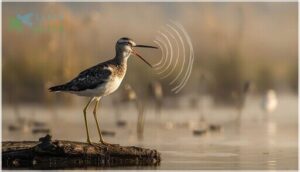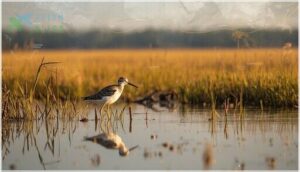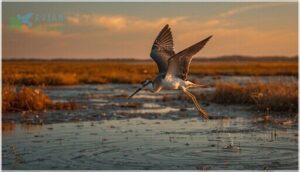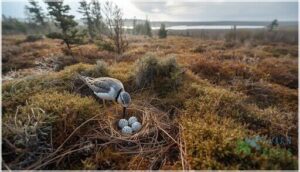This site is supported by our readers. We may earn a commission, at no cost to you, if you purchase through links.
You’ve likely passed by dozens of greater yellowlegs without giving them a second thought—just another brown shorebird probing the mud with a bunch of others. But those bright yellow legs aren’t just for show. They’re actually working overtime, helping these birds spot prey in murky water, regulate body temperature in extreme climates, and even catch the eye of potential mates during breeding season.
These long-legged travelers don’t fool around regarding migration either, covering distances from Alaska’s tundra to Argentina’s wetlands with precision that would make a GPS jealous. What makes them stand out in a crowd of lookalike shorebirds goes way beyond leg color, though—from their distinctive calls echoing across marshes to their head-bobbing feeding rituals.
Table Of Contents
- Key Takeaways
- Greater Yellowlegs Identification and Appearance
- Habitat and Geographic Distribution
- Behavior and Migration Patterns
- Diet and Foraging Strategies
- Nesting Habits and Conservation Status
- Frequently Asked Questions (FAQs)
- How do Greater Yellowlegs protect themselves from predators?
- What is the average lifespan of a Greater Yellowlegs?
- Can Greater Yellowlegs be found in urban areas?
- How do Greater Yellowlegs adapt to changing water levels?
- Are Greater Yellowlegs social birds that live in flocks?
- How long do Greater Yellowlegs typically live?
- Do Greater Yellowlegs have any natural predators?
- Can Greater Yellowlegs be kept as pets?
- How do Greater Yellowlegs communicate with each other?
- What threats do Greater Yellowlegs face during migration?
- Conclusion
Key Takeaways
- Greater yellowlegs use their bright yellow legs for multiple survival functions including prey detection in murky water, thermoregulation during extended wading, and mate attraction during breeding season.
- These shorebirds complete extraordinary migrations spanning from Alaska’s tundra to Argentina’s wetlands, relying on critical stopover wetlands that have declined by nearly 50% since the 1950s across North America.
- You can reliably identify greater yellowlegs by their bill length (1.25-1.5 times head length), distinctive three-note alarm call, and seasonal plumage shifts from heavily barred breeding patterns to plain gray winter coloration.
- Their foraging success depends on specific shallow water depths of 5-18 centimeters where they achieve 30-50% prey capture rates using tactile bill-sweeping motions and visual hunting techniques.
Greater Yellowlegs Identification and Appearance
If you’re trying to identify a Greater Yellowlegs in the field, you’ll want to know what sets this elegant shorebird apart from similar species. Several key features make this bird recognizable, from its physical build to the sounds it makes.
Let’s walk through the most reliable identification markers you can use during your next birding outing.
Distinctive Bright Yellow Legs
You’ll spot Greater Yellowlegs by their signature bright yellow legs, which serve multiple purposes beyond identification. Leg pigmentation enhances foraging efficiency in shallow waters while playing a role in mate selection and thermoregulation during extended wading. These long legs contribute to impressive survival rates, with their vivid color remaining consistent across seasons.
Greater Yellowlegs are considered long distance migrants, often seen in small flocks during the spring and fall. The yellowlegs’ appearance makes field identification straightforward, as this physical characteristic stands out among mixed shorebird flocks.
Bill Length, Shape, and Color
You’ll find the Greater Yellowlegs’ bill measures 59–65 mm long, roughly 1.25–1.5 times its head length—a key identification marker. This upturned bill starts thick at the base and tapers to a blunt tip. During breeding season, you’ll see a solid dark bill, while non-breeding plumage reveals a lighter gray base. Bill length variation between sexes stays minimal, making comparative morphometrics reliable for field identification. The bill shape and size are key to differentiating it from the smaller Lesser Yellowlegs.
- The bill’s length accounts for 15–22% of total body length
- Breeding bill color appears uniformly black with glossy saturation
- Non-breeding color shows pronounced paleness at the base quarter
- Bill shape details include subtle upward curvature of 5–8° in some individuals
Greater Yellowlegs identification relies heavily on bill thickness compared to Lesser Yellowlegs.
Plumage Patterns and Seasonal Changes
Beyond the bill, you’ll notice the Greater Yellowlegs undergoes distinct seasonal transformations. Breeding plumage, from March through September, showcases bold dark barring on the flanks and heavy streaking across the head and neck. Winter plumage turns grayish overall with minimal markings, while juvenile birds display muted patterns with spotting on wings. Molting timelines vary—some adults start as early as July, completing the shift by late fall.
| Plumage Type | Key Characteristics |
|---|---|
| Breeding | Heavy barring, checkered appearance, solid black bill |
| Winter | Gray tones, faint streaking, lighter bill base |
| Juvenile | Muted patterns, thin breast streaks, wing spotting |
| Molt Timing | July start, January-March completion range |
Size and Body Structure
Greater Yellowlegs characteristics reveal a medium-sized shorebird measuring 29 to 40 centimeters long, with a wingspan stretching 60 to 80 centimeters. Sexual dimorphism is nearly absent—both sexes weigh 111 to 250 grams with identical proportions.
Skeletal adaptations include pointed wings for long-distance flight and sturdy legs for wading. Diagnostic markers like the thick-based bill (1.5 times head length) help you distinguish this species instantly.
Call Patterns and Vocalizations
You’ll most often hear a sharp, ringing “tew, tew, tew”—three clear notes that serve as the Greater Yellowlegs’ signature alarm call. This bird’s vocalizations repertoire includes territorial songs during breeding, contact chips while foraging, and flight calls for group cohesion.
Call frequency spikes near nests when predators approach. The vocal complexity and louder voice distinguish this species from Lesser Yellowlegs, making species identification straightforward in mixed shorebird flocks.
Habitat and Geographic Distribution
You’ll find Greater Yellowlegs spread across a vast stretch of the Americas, from the boreal forests of Canada and Alaska all the way down to the southern tip of South America. Their choice of habitat shifts with the seasons, taking them from remote northern breeding grounds to coastal wetlands and mudflats during migration and winter.
Let’s look at where these elegant shorebirds spend their time throughout the year.
Breeding Grounds in Northern Regions
If you’re tracking Greater Yellowlegs back to their origins, you’ll need to venture north into Canada’s vast boreal breeding range and subarctic breeding territories. Over 80% of their nesting happens across remote Canadian bogs and tundra, stretching from Newfoundland west to Alaska.
These breeding areas feature mossy muskeg dotted with shallow ponds—ideal for raising nestlings. Population monitoring remains challenging due to their low-density nesting habits across such expansive, isolated landscapes.
Preferred Wetlands, Marshes, and Mudflats
During migration, you’ll spot these shorebirds in wetland habitats where marshes meet exposed mudflats—their preferred staging areas. Habitat preferences center on shallow water (2–8 cm deep) supporting mudflat invertebrate prey. Salinity influence matters: salt marshes host denser populations than freshwater sites.
However, habitat loss from wetland management changes and climate impacts threatens stopover availability, with Wisconsin alone losing 47% of historical foraging areas since settlement.
Habitat loss and climate change have eliminated nearly half of Wisconsin’s historical yellowlegs foraging areas since settlement
Wintering Areas and Migration Destinations
When winter arrives, these birds can be found along a vast range, from the southeastern U.S. coast all the way down to Argentina. Their migration routes are heavily influenced by stopover ecology, particularly wetlands that provide essential resources for their long journeys.
Here are some key areas that play a crucial role in their migration:
- Gulf Coast and California shores host substantial overwintering populations
- Mississippi Alluvial Plain provides critical passage habitat for 25% of northbound migrants
- Prairie Pothole Region bolsters over 65% of southbound travelers
- Coastal lagoons across Central and South America concentrate birds November through March
- Habitat loss remains the primary environmental pressure, with conservation needs focusing on protecting these wintering grounds and migration patterns
Range Across North, Central, and South America
You’ll find Greater Yellowlegs spanning an impressive geographic range across the Americas. Their breeding regions stretch through Canada’s boreal forests and into Alaska, while wintering grounds reach from the southern U.S. through Central America to Argentina and Chile.
The species relies on both Atlantic and Pacific migration flyways, though habitat loss threatens critical stopover sites. Recent range expansion into artificial wetlands offers some hope amid ongoing wintering habitat challenges.
Behavior and Migration Patterns
Greater Yellowlegs aren’t the type to sit still—they’re constantly on the move, whether they’re foraging in shallow water or embarking on their impressive migrations across continents. You’ll notice their distinctive behaviors long before you get a good look at their yellow legs, from the way they bob their heads while hunting to their loud, unmistakable calls echoing across wetlands.
Let’s explore what makes these shorebirds such fascinating travelers and how their seasonal patterns shape their yearly cycle.
Head Bobbing and Foraging Behavior
You’ll notice Greater Yellowlegs foraging behavior includes constant head bobbing—averaging 18 to 25 bobs per minute while feeding. This bobbing frequency increases dramatically to 34 per minute just before they strike at prey.
They forage in shallow water, usually less than 10 centimeters deep, using visual and tactile prey detection methods. Their capture success rate averages 32% per attempt, influenced strongly by environmental factors like tidal movements and weather conditions.
Solitary Vs. Flock Behavior
You’ll see these shorebirds display striking shifts in avian behavior throughout the year. Breeding solitude dominates May through July, while roosting aggregations form nightly during fall passage, driven by habitat influence and predation pressure.
Over 75% of Greater Yellowlegs forage alone outside migration, maintaining foraging distances of 10–30 meters between individuals. During migration flocking peaks, however, groups swell from solo birds to 5–50 individuals—sometimes reaching 200 at rich stopovers.
Migration Timing and Routes
Migration patterns shift when adults leave breeding grounds by late June to early July, following well-defined flyways through interior wetlands and coastal estuaries. Spring arrival dates hit peak numbers from early March to April across the southern United States. Juveniles depart 4–6 weeks after adults, with fall departure cues extending into November.
Route variations span from Alaska to Argentina, utilizing critical stopover ecology sites where you’ll spot tight groups refueling for hundreds of kilometers ahead.
Display Flights and Courtship Behavior
Once yellowlegs reach breeding grounds, males launch into undulating aerial displays—rapid wingbeats alternating with glides over bogs and tundra. These display flights peak between late May and mid-June, averaging 12–25 seconds each. Ground rituals follow, where males circle females with quivering wings before copulation.
Behavioral insights reveal:
- Morning hours see 60% of courtship vocalizations and territoriality displays
- Display frequency drops 80% after nest establishment
- Pairs space nests 50–200 meters apart through social interactions
- Breeding songs contain 5–8 high-pitched notes during flight
Diet and Foraging Strategies
Greater Yellowlegs are opportunistic feeders that rely on shallow water habitats to find their meals. Their diet shifts throughout the year depending on what’s available, but you’ll usually see them going after small aquatic creatures with impressive speed and precision.
Let’s look at what these shorebirds eat and how they hunt for food in their wetland environments.
Aquatic Insects and Small Fish
What drives a Greater Yellowlegs diet? Primarily aquatic insects and small fish. During the breeding season, insect prey selection—especially beetles and dragonfly larvae—accounts for over 60% of their intake. Seasonal diet shifts occur as fish capture rates increase during migration, with minnows and killifish becoming prominent. Their foraging techniques, including rapid bill sweeps and active chasing, demonstrate considerable ecological impact on wetland prey populations.
| Prey Type | Peak Consumption Period |
|---|---|
| Aquatic insects (larvae) | Breeding season (June–July) |
| Small fish (minnows, killifish) | Migration/Winter (Sept–March) |
| Mixed prey availability | Stopover sites year-round |
Consumption of Crustaceans and Snails
Beyond insects, you’ll find crustaceans constituting up to 25% of their diet during winter, with shrimp and crabs consumed in 60–80% of coastal feeding bouts. Snails appear in 40% of tidal mudflat observations, delivering roughly 18% of protein intake.
Regional diet shifts are striking—crustacean caloric intake jumps 35% in coastal versus inland sites. Prey handling times average 5.1 seconds for crustaceans, directly influencing ecosystem nutrient cycling.
Foraging Techniques in Shallow Water
Watching these birds work shallow water reveals precision you won’t forget. Their bill-sweeping motion cuts side to side 7–12 times per minute, detecting invertebrates by touch in depths under 15 centimeters.
Feeding behavior follows distinct temporal patterns and social dynamics:
- Prey capture rate: 30–50% success per foraging attempt
- Depth preferences: 5–18 centimeters improve efficiency
- Competition: Aggression rises in groups exceeding six birds
Seasonal Variations in Diet
Throughout the year, you’ll see Greater Yellowlegs shift their diet dramatically as seasons change and prey availability fluctuates. Spring insect consumption dominates breeding season feeding behavior, while summer protein intake increases to support post-breeding needs. Autumn larval diet peaks during migration, and winter invertebrate reliance defines coastal foraging strategies.
Habitat dietary shifts reshape their invertebrates menu as these adaptive birds move between freshwater wetlands and tidal zones.
| Season | Primary Diet Components |
|---|---|
| Spring Breeding | Aquatic insects (60%+), small fish (20%) |
| Fall Migration | Dipteran larvae (35%), crustaceans (18%) |
| Winter Grounds | Aquatic invertebrates (50%+), mudflat prey |
Nesting Habits and Conservation Status
When you think about shorebirds nesting in the wild, the Greater Yellowlegs takes a surprisingly secretive approach to raising its young. These birds build their nests in remote northern regions, carefully hiding them from predators while working through the demanding task of incubation.
Let’s look at how they nest, what their current population status tells us, and the conservation work that’s helping protect them.
Ground Nesting and Nest Concealment
You’ll find Greater Yellowlegs nesting on the ground in remote boreal bogs, where they rely on clever concealment tactics to protect their eggs. Nest site selection favors moss hummocks near water, creating natural fortresses against predators.
Their nesting habits include these predator evasion tactics:
- Placing nests at tree bases or near logs for partial concealment
- Camouflaging eggs with moss, leaves, and lichen
- Selecting microhabitat preferences with dense shrub cover
- Positioning within 100 meters of shallow water bodies
Nesting success rates commonly range from 30% to 44%, with clutch survival factors heavily influenced by vegetation density and how well nestlings can hide once they hatch.
Egg Laying and Incubation Periods
You’ll witness Greater Yellowlegs laying a clutch size of three to four eggs per season, usually in May. Egg coloration ranges from smoky-gray to olive with irregular brown spots, blending perfectly into the nest.
Both parents incubate for 23 days, sharing parental roles throughout nesting and breeding.
Hatchlings leave the nest within hours, reaching fledging success in 18 to 20 days with survival rates around 75% to 85%.
Population Trends and Threats
The global population stands at roughly 100,000 individuals, with stable trends observed across North America. However, wetland loss threatens their future—50% of North American wetlands disappeared between 1950 and 2009.
Climate impacts, including habitat shifts from rising temperatures, compound these challenges. While contaminant effects remain minimal and hunting history no longer poses risks, ongoing habitat loss and human disturbance continue threatening this species’ long-term survival.
Conservation Efforts and Habitat Protection
Thankfully, you can support conservation efforts addressing habitat loss through multiple channels:
- Wetland restoration projects have reclaimed over 25 acres at sites like Wye Island, permanently protecting migratory stopovers.
- Land acquisition programs secured 565 hectares of priority habitats across breeding and wintering grounds.
- Funding mechanisms like the proposed Recovering America’s Wildlife Act could provide $1.4 billion annually for habitat protection.
- Regional collaboration through the Neotropical Migratory Bird Conservation Fund protects 221,000+ hectares internationally.
Climate mitigation through wetland preservation strengthens ecosystem resilience for greater yellowlegs.
Frequently Asked Questions (FAQs)
How do Greater Yellowlegs protect themselves from predators?
You’ll often hear their piercing three-note alarm call before spotting danger—it’s their first line of defense.
Greater Yellowlegs use nest concealment, flocking defense, and evasive flight to outsmart predators through behavioral patterns and social interactions.
What is the average lifespan of a Greater Yellowlegs?
You’ll find the Greater Yellowlegs lives 5 to 11 years in the wild, though some reach Survival rates depend on habitat quality, predation, and disease. Banding data shows fewer than 10% surpass a decade.
Can Greater Yellowlegs be found in urban areas?
Like discovering unexpected wildflowers in sidewalk cracks, you’ll spot Greater Yellowlegs at city wetlands. Urban sightings occur in 28 metropolitan areas, with habitat preferences favoring restored parks. These adaptable shorebirds navigate temporal distribution patterns during migration peaks.
How do Greater Yellowlegs adapt to changing water levels?
You’ll notice these shorebirds wade deeper when water rises, switching foraging techniques from probing mudflats to sweeping through ankle-deep pools.
Their nesting location choices in bogs naturally accommodate seasonal flooding, protecting eggs from predators.
Are Greater Yellowlegs social birds that live in flocks?
Greater Yellowlegs lean toward solitary foraging rather than sustained flocking. You’ll spot them alone about 65% of the time during migration, though they form small groups of 2-20 birds for roosting behavior and migratory flights.
How long do Greater Yellowlegs typically live?
You can expect these shorebirds to live approximately 5 to 11 years in the wild, with most surviving fewer than 8 years. Banding data shows the longest confirmed Greater Yellowlegs lifespan reached 11 years.
Do Greater Yellowlegs have any natural predators?
Yes, you’ll find that Greater Yellowlegs face mammalian threats from foxes and raccoons, plus avian predators like ravens and harriers. Nesting vulnerability peaks during daylight hours, though defensive adaptations and alarm calls help protect eggs and chicks.
Can Greater Yellowlegs be kept as pets?
You can’t legally keep these birds as pets. Legal prohibitions under the Migratory Bird Treaty Act protect them.
Captivity welfare concerns and care barriers make it impractical and unethical for domestic ownership.
How do Greater Yellowlegs communicate with each other?
Actions speak louder than words, but for these shorebirds, vocalizations are essential. You’ll hear their loud, ringing calls—usually three to four notes—alerting others to threats, coordinating migration, and even courting mates.
What threats do Greater Yellowlegs face during migration?
You’ll encounter multiple threats during migration, including habitat degradation from wetland loss, hunting pressure in some regions, climate change impacts on stopover sites, human disturbance, and contaminant exposure near agricultural areas.
Conclusion
Whether you’re scanning mudflats or watching wetlands shift with the seasons, recognizing greater yellowlegs transforms every outing into something richer. Their yellow legs aren’t just identification markers—they’re survival tools honed across continents.
As these birds navigate shrinking habitats and changing climates, your awareness matters. Each sighting you log, each wetland you help protect, contributes to their story.
Next time those bright legs catch your eye, you’ll know exactly what you’re seeing—and why it counts.
- https://www.lifeoncsgpond.com/greater-yellowlegs
- https://www.birdweb.org/Birdweb/bird/greater_yellowlegs
- https://www.chesapeakebay.net/discover/field-guide/entry/greater-yellowlegs
- https://www.bto.org/learn/about-birds/birdfacts/greater-yellowlegs
- https://www.allaboutbirds.org/guide/Greater_Yellowlegs/maps-range













